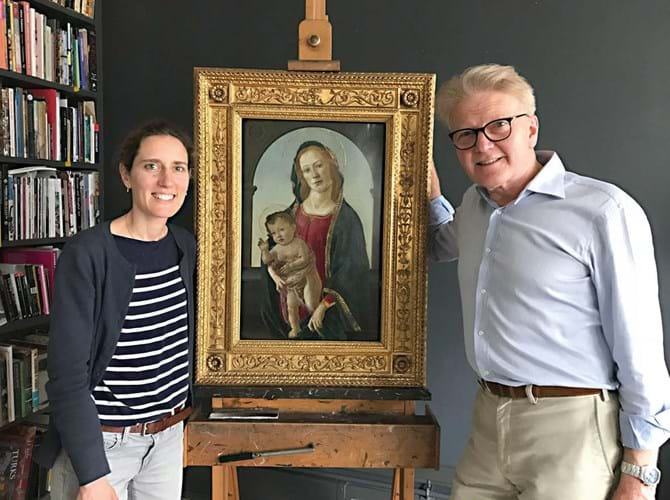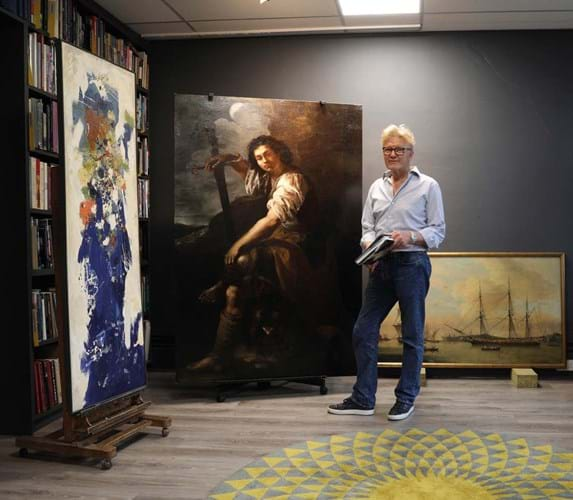Gillespie founded his business in 1982 and more recently has brought the world of art restoration into the nation’s living rooms with his appearances in art dealer Bendor Grosvenor’s BBC4 series Britain’s Lost Masterpieces (with presenter and historian Emma Dabiri).
ATG: How did you get into restoration/ conservation and pictures particularly?
Simon Gillespie: Having trained as a cabinet maker and during that period carried out restoration on many pieces of furniture, I was approached by a friend with a very ancient painting and asked whether I’d know how to restore it.
I was living in Mexico at the time, and we took it to the local paintings conservator, who I thought began to treat the picture with great disdain. It was a lightbulb moment and I returned to England and found training in two studios, also taking chemistry classes and art history courses and lectures. I have never looked back.
I have always considered it a great privilege to be able to pick up a great artist’s work and stand in front of it as they would have done, rather than from behind a museum rope.
Describe a conservation or restoration project that you are most proud of
One of the works we’ve treated quite recently in the studio was by the long-overlooked female artist Artemisia Gentileschi (1593-1653).
It was brought into the studio covered in dirt and overpaint, having been cleverly purchased by an attentive and learned private collector who recognised it. During cleaning the cherry on the cake was actually to find the signature that had been covered with overpaint in the past.
The painting was then shown to the various experts on the artist and with great excitement has been hailed a great find. It’s hopefully going on public display soon.
How do you manage your emotions when a client hopes their picture is by a well-known artist but the evidence you uncover begins to suggest it is a later copy?
It is sometimes very stressful when someone brings in a family heirloom with huge expectations of solving their grandchildren’s university fees and heart-breaking to give them the news that the picture is not what they’d hoped.
Although we’ve had some huge successes with proper attributions, sometimes other attributions may not have been what the client was expecting. It is always an exciting journey.
Thinking of the wider world of restoration/conservation – is it a dying art?
As technology moves on and our materials get better and the way we look after art is so much improved, we are almost doing ourselves out of a job as a profession!
The longevity of the treatment of paintings is now extended fivefold. But there is a huge amount of art that does need looking after. Conservation is not a dying art; the university courses take it very seriously and the talent being produced from these courses is at an extremely high standard.
The courses naturally take only a few students at a time. I would say that personally I would like to be able to offer more practical experience to some of these students, and I’m hoping to set up a grad scheme with this in mind.
Do you collect art or antiques for your home? If so, what do you buy?
I have a few treasured Old Masters and I find it very exciting to see new talent coming out of today’s art schools, especially in London as there is a very good intellectual standard and I would say it’s the centre of Contemporary Art.
I try to pick up something every year from each of these exhibitions. This is also balanced with a love of pre-Columbian art and statuary.
How concerned are you with the apparent rise in faked Old Masters pictures? Do you think it is increasing or is the detection rate increasing?
This question makes me laugh! We have got techniques now that are incredible for spotting fakes. However, whenever I go to a conference on new conservation techniques I always get the feeling that a lot of the information is being gathered by fakers as well and they are learning to stay a step ahead.
Normally a faker would choose a single artist and become very proficient at replicating their techniques using the same materials.
There is a forger in Italy who has the extraordinary skill of being able to produce works of art from different artists across different countries and periods using the correct materials and techniques. They have been the spotlight in many court cases where it has been very difficult to prove one way or another in some instances.
Do you think there is still room for the connoisseur in art or are technology and science taking over?
There is definitely room for connoisseurship and there always will be. There is nothing better than the human eye and the human mind to analyse and describe what an artist is trying to achieve.
It is a wonderful experience to be with a person who knows their subject and is also generous enough to share their knowledge.
The greatest connoisseurs, of course, are normally the ones who’ve spent the longest time at it. They will not be replaced by technology: technology plays its part normally in excluding an artwork from an artist’s canon, for example the simple analysis of finding pigments on a painting that did not exist when that painting is supposed to have been made, or with an x-ray finding a portrait of Mussolini under a supposed Brueghel.
















